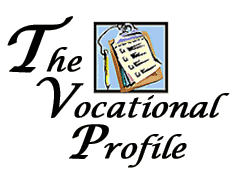Lesson 2: Rehabilitation: A Case Study Approach (Developing a Vocational Profile)
Attention

Learning Outcomes
Upon completion of this lesson's material, students will be able to:
- Identify the components of a vocational profile
- Comprehend how each component provides information that impacts an individual with disabilities in an employment setting.
Teaching
As you read Chapter 1 in the course text (Brodwin) you will learn that the key to understanding the vocational aspects of disabilities, is understanding the consumers "Vocational Profile" or comprehensive assessment of rehabilitation needs. Vocational Profile components are specifically reviewed in pages 1-10 in Brodwin and include:
- Age at onset of disabling condition
- Current age
- Economic factors- source of income (SSI, SSDI, UI, family, work)
- Severity of disability including impact on function and limitations
- Gender and ethnicity
- Education and vocational background
- Psychological and motivational factors
- Work History
- Skills and knowledge
- Psychosocial adjustment to disability
- Living situation
- Social functioning
Vocational Aspects of Disabilities are learned in the context of this vocational profile and how this profile fits with the employment systems in the community. Community based employment services are provided based on an understanding of this profile. Each individual vocational profile comes from the experience of that individual in the workforce development systems discussed last week.
You as an MHRT will not, in most cases, be responsible for completing this in depth analysis to the extent required by Social Security or an Individualized Plan for Employment at VR , but you will be responsible for understanding it as it relates to the consumers employment service plan, and any work you do with that consumer supporting them in finding a suitable job.
This vocational profile or case study approach is one part of the holistic approach to providing effective and sustainable rehabilitation services to individuals with disabilities. This is one of the 10 components of Recovery that will be discussed in Week 4.
Studying case information about consumers who are seeking an employment outcome gives a practical experience to learning how to assist individuals with disabilities with entering the workforce. Much of the vocational analysis material in the text (Brodwin) and the Transferable Skills Analysis (Fields) supplement refer to the Dictionary of Occupational Titles http://www.occupationalinfo.org/contents.html job descriptions and corresponding tasks, aptitudes and functions. This system of job analysis and categorization has been used by The Social Security Administration and the rehabilitation profession since the Rehab Act of 1973. The United States Department of Labor has replaced this job categorization with O’Net http://online.onetcenter.org which is still developing the tool. Onet has labor market information for identifying emerging careers and industries and is a good resource for understanding employment.
It is important to become familiar with the O'Net system as this is the current system used by the Department of Labor for labor market research which you will use in the job development function in this course and in the community if that is part of your job. In any event as a case manager the consumer you work with will be looking at work. The better you understand how this assessment is done the better you can education the consumer and others who are responsible for job development.
Reading Assignments and/or Document/Internet Web site Review:
- Chapter 1 (Brodwin) – Rehabilitation: A Case Study Approach (pages 1-16)
- Briefly review the content of the Dictionary of Occupational Titles at the ONet site
Assessment
Lesson 2 Discussion
Discuss why it is so important to gather all this information in a vocational profile prior to discussing details about vocational goals and plans.
Lesson 2 Quiz
- List the components of a vocational profile listed in the text and briefly describe the impact each might have on employment?
- Write a brief vocational profile of yourself. If a particular component does not pertain to you just put N/A
- List the Vocational Profile components that are found in the DOT and ONET systems of classifying.